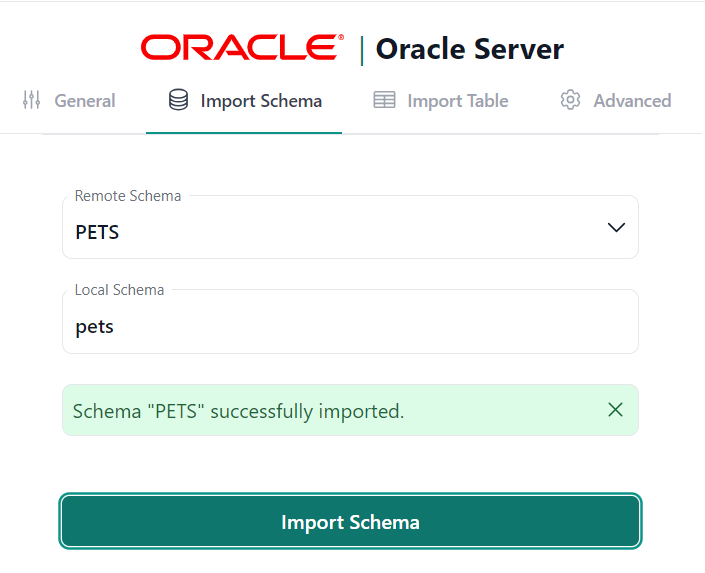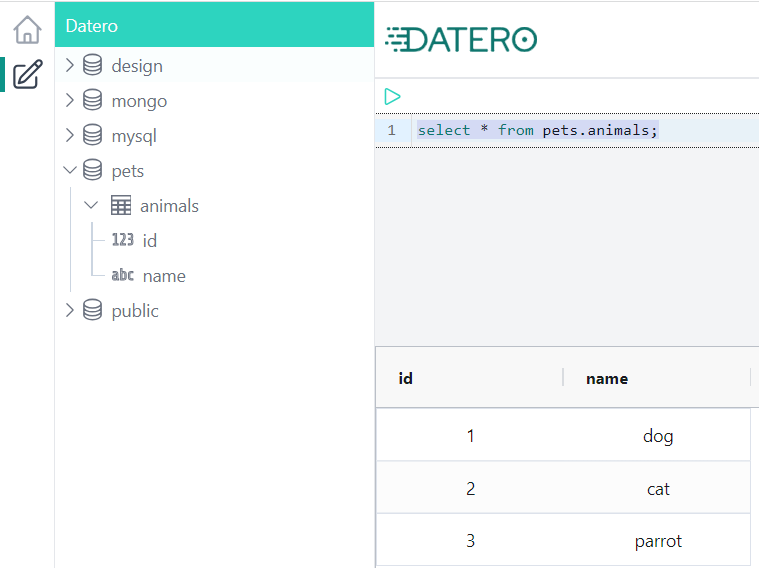Oracle¶
This section describes how to connect to Oracle database from Datero.
Notice
Used approach is identical to the one described in the MySQL section.
Environment¶
If not running, let's start datero container created in the installation section.
Connectivity pattern
To emulate external host connectivity, we will use container 2 container approach.
We will create do network and connect datero container to it.
Then we will run datasource oracle container and connect it to the do network as well.
Now, let's create do network and connect datero container to it.
Also make it resolvable under the datero hostname.
To get Oracle database we can use official oracle container registry.
On that page there is a Database product category tile.
Inside this category there is a Oracle Database Free repository.
As everything with Oracle, image is big. It's about 3Gb in compressed size. Let's pull the image first.
Now run the container, connect it to the do network and make it resolvable under the oracle_db hostname.
We also set password for the sys, system and pdbadmin users to the admin value.
docker run -d --name oracle \
--network do --network-alias oracle_db \
-e ORACLE_PWD=admin \
container-registry.oracle.com/database/free:latest
oracle container from the datero container by its hostname oracle_db.
Oracle database¶
Since version 12c, Oracle installation is already multitenant architecture with main Container (CDB) and Pluggable (PDB) databases. From architecture point of view it became similar to Postgres or MySQL. Where single installation is a cluster which could have multiple databases.
Inside Oracle Database Free installation CDB is served over FREE listener service. While PDB is served over FREEPDB1 service.
Having oracle container running, we can connect to the default pluggable database and create some test data.
SQL*Plus: Release 23.0.0.0.0 - Developer-Release on Sat Jun 10 16:00:08 2023
Version 23.2.0.0.0
Copyright (c) 1982, 2023, Oracle. All rights reserved.
Connected to:
Oracle Database 23c Free, Release 23.0.0.0.0 - Developer-Release
Version 23.2.0.0.0
SQL> create user pets identified by pets
default tablespace users temporary tablespace temp
quota unlimited on users;
User created.
SQL> grant connect to pets;
Grant succeeded.
SQL> grant create table to pets;
Grant succeeded.
Now reconnecting already under pets user.
Because we are inside sqlplus session within the container we can use localhost as the hostname.
SQL> conn pets/pets@//localhost:1521/freepdb1
Connected.
SQL> create table animals(id number, name varchar2(100));
Table created.
SQL> insert into animals values (1, 'dog'), (2, 'cat'), (3, 'parrot');
3 rows created.
SQL> commit;
Commit complete.
Now we are ready to connect to the oracle database from datero.
Datero connection¶
Open Datero web ui at http://localhost and click on the Oracle entry in the the Connectors navigation section on the left.
Enter any descriptive name in the Description field. For example, Oracle Server.
Enter //oracle_db:1521/freepdb1 as the Dbserver value.
Where oracle_db is that custom hostname that we specified when were launching oracle container in the do network.
And freepdb1 is the name of the pluggable database service that we want to connect to.
This emulates external host connectivity.
In a real-world case, the situation would be similar.
If you have, for example, Oracle running on oracle-host.my-company.com hostname and
it's resolvable from the machine where datero container is running, you can use that hostname instead.
Specify pets as the User value. For the password use pets as well.
We created this user when connected under the sys user to the freepdb1 database in the previous section.
Click Save to create the Server logical object.
| Connector | Connection Form |
|---|---|
 |
 |
Schema import¶
After the Server is created, we can import database schema from it.
Connection wizard will switch the tab and open Import Schema form.
In the Remote Schema drop down select you will be able to pick-up pets schema,
that we created earlier in source oracle database.
User vs Schema
In Oracle, user and schema are the same thing.
So, when we created pets user, we also created pets schema.
| Server Object | Import Schema |
|---|---|
 |
 |
For example, we want to import pets schema into the same pets local schema.
To do that, type pets into the Local Schema input field and click Import Schema button.
Important
Schema import doesn't physically copy any data. For every source table and view it creates an object of a special type in a local schema. This object type is called foreign table. It implements data virtualization pattern.
Querying foreign table will automatically fetch data from the source database. If supported by connector, any filtering, sorting, grouping, etc. will be pushed down to the source database. This means that only the data that is needed will be fetched.
If you change the schema in the source database, you will need to re-import it in Datero to reflect the changes.
Thus, schema evolution is handled automatically just by re-importing the schema.
If everything is correct, you will see the success notification message.
We are ready now to query our Oracle database from Datero.
Data Querying¶
Click on the Query Editor icon in the left navigation panel.
You will see pets schema in the Datero object tree.
If you expand it, you will see animals table from original oracle database.
Its definition was automatically imported.
To query data just write a query in the editor and press Ctrl+Enter or click green Run button above.
And that's it! You have successfully connected to the Oracle database from Datero and queried the data.
Summary¶
Of course, having just a single datasource is not very interesting. It's non-distinguishable from the direct connection to Oracle via any other tool, like DBeaver. But the real power of Datero is in its ability to connect to multiple datasources and join data from them.
This is what is not possible via the "direct connection" tools. Even if they support connecting to multiple datasources, they don't support joining the data from them.

